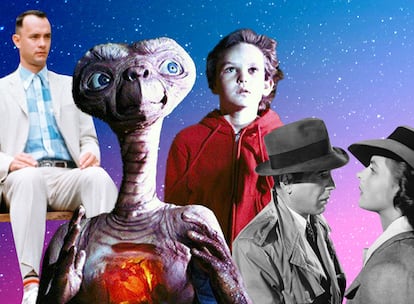‘ET II’? ‘Return to Casablanca?’ The movie sequels that almost were
As the 40th anniversary of Steven Spielberg’s film approaches, social media has rediscovered a nine-page treatment in which the director describes the plot of a never-shot second installment, one of several examples in which Hollywood tried to extend a box office phenomenon


The world of film is full of surprising sequels, many released decades after the success of the original. In 1985, someone thought it was a good idea to release Return to Oz, a sequel to The Wizard of Oz. In 1983, Psycho II brought viewers back to the twisted world of Psycho. In 2006, a new installment of Basic Instinct was released and subsequently became a failure in every possible way. This summer will see the release of another Top Gun movie. But the list could have been much longer. As Hollywood prepares to celebrate 40 years of E.T. the Extra-Terrestrial (Steven Spielberg, 1982), social media users have once again remembered the plans for an E.T. sequel, which went no further than a nine-page document already legendary on the internet. The never-shot second part of E.T., and the rest of the cases on this list, show that sometimes in Hollywood common sense does prevail over greed.
E.T. II: there are more, and they’re evil!
A nine-page document available on the internet that explains the plot of E.T. II in detail. Steven Spielberg and Melissa Mathison, director and co-writer of E.T. the Extra-terrestrial (1982), came up with the second installment, Nocturnal Fears, shortly after the originally film became a hit. Film experts and fans agree that the decision to discard the project was the right one.
The film reveals that E.T’s planet is home to two warring civilizations of creatures similar to the friendly alien from the first installment. This time, the bad guys return to Earth looking for E.T.. The extraterrestrials resemble the alien that we met before, but according to Spielberg’s description, they are albino and carnivorous, with pink eyes and elongated fangs. On their return, they meet the Elliott brothers, Gerty and Michael, who after their space adventure are trying to get on with their lives and prepare for summer. But their plans are cut short when they are kidnapped by hostile aliens. In a spaceship similar to the one in which they bid goodbye to their friend, they are interrogated about the whereabouts of E.T., who we learn is really named Zrek. E.T. receives Elliott’s distress call telepathically and returns to save the boys. And once he does, he leaves again: it’s not an E.T. movie without a devastating farewell scene.
To the casual reader, this may seem like an unimpressive plot unbecoming of Spielberg. In reality, though, it is a mere outline for a story that, if filmed, would probably have shone in another way. (The original E.T., if we sum it up like that, is a story of a telepathic alien who comes to Earth and befriends a boy). But no matter how well it had turned out, it probably would have cheapened the original film’s legacy: an E.T. albino with pink eyes and sharp teeth? Child abduction scenes? Spielberg has historically chosen well when deciding which sequels of his own films to direct. When he said yes, he shot works including Indiana Jones and the Temple of Doom (1984) and The Lost World (1997). When he said no, he avoided Jaws 2. You don’t become the most influential contemporary director without making shrewd decisions.
Forrest Gump’s sick son
In 1994, in the wake of the massive success of Forrest Gump (1994′s highest-grossing film worldwide), author Winston Groom published Gump & Co., a sequel to the 1986 novel that had inspired the original film. He may have been the first person to feel relieved when this second story never reached the big screen. He never really liked the fact that the Forrest he had written about, a rotund man who cursed prolifically, and who he had always imagined being played by John Goodman, was reduced in the movie to Tom Hanks’s thin and angelically sweet character.
Eric Roth, the Oscar-winning screenwriter who wrote the first installment, was commissioned to adapt the second. He chose not to stick too closely to the novel, imagining a story that, like E.T. II, takes its liberties with the source material. In the never-made movie Gump & Co., Forrest Gump’s son, named after him, is rejected at school because, like his late mother, he has AIDS. In another scene, Forrest Gump ends up in the back of the SUV that O.J. Simpson used in his spectacular escape from the police before being arrested. And in another, he witnesses the 1995 bombing of a federal building in Oklahoma in which 168 people died. Perhaps to make use of the special effects that shocked the world in the first installment, Gump also coincides with Princess Diana at a party and dances with her.
The never-shot second installment seems like a slightly darker recapitulation of the device that worked in the first: the protagonist ending up by chance in the middle of the most notorious recent events in the United States. According to Eric Roth, in an interview with Yahoo, the shoot was canceled for an even darker reason: he delivered the final script to Universal Pictures on September 10, 2001. The very next day, the world would change, and, with it, the stories that Hollywood wanted to tell.
Seven Two. That is, Eight
The never-shot second part of Seven (David Fincher, 1995) shows the more cynical side of Hollywood. It’s one of those cases where an artistic project is forced into another mold to take advantage of the circumstances. Seven was a surprise in 1995: a dark, violent, sad movie with a tragic ending that ended up becoming one of the highest grossing films of the year. They were different times. A story with such a perfect ending didn’t demand a sequel. Out of the four protagonists, two end up dead, another is arrested and the other about to retire. But the industry can always find a way.
In 2002, New Line Cinema received a script from Ted Griffin (Ocean’s Eleven) about a detective with psychic powers who hunts down a serial killer who also has psychic powers. Someone had the idea to adapt the plot so that the main detective would be William Somerset, Morgan Freeman’s character in Seven who, apparently, did not retire and went on to develop telepathic abilities.
David Fincher was the first to speak against the project. During a meeting with the press and fans in New York in 2008, while celebrating the premiere of The Curious Case of Benjamin Button (which reunited him with Brad Pitt, the policeman from Seven), a fan asked the director why he never decided to direct that script. He replied, “I would have less interest in that than I would in having cigarettes put out in my eyes.” Morgan Freeman also refused to get back into the detective’s suit. The script was shot with the original plot and released in 2015 as Solace. The film, starring Anthony Hopkins, Jeffrey Dean Morgan and Colin Farrell, received negative reviews and was forgotten. But we will always remember that cardboard box.
Casablanca 2. Seriously
A sequel to Casablanca? The idea is almost as old as the movie, which was released in 1942 and quickly became a success, despite a chaotic shoot in which the script was often changed on the fly. The producer Warner Bros spent decades fantasizing about the idea of a sequel. And although almost no one remembers it, in a way, it happened.
The first idea that the production company considered was called Brazzaville. According to The New York Times, the script was going to be written by Frederick Stephani (who would end up writing the 1960s sci-fi series Flash Gordon). Warner Bros had already considered adding a scene at the end of Casablanca in which Rick (Humphrey Bogart) and Captain Renault (Claude Rains) board a ship with Allied troops. Where to? The title of that supposed sequel suggests that they were headed to Brazzaville, the capital of the Congo. Stephani’s script reveals that Rick and the captain had been undercover agents all along, which would have ruined two of the most memorable elements of the end of the film: the conversion of Renault (a collaborator who converted in Casablanca) and Rick’s personal sacrifice, letting go of Ilsa (Ingrid Bergman) in order to save her.
It was not the only attempt to continue Casablanca’s story. In 1980, Howard Koch, one of the screenwriters of the original film, wrote Return to Casablanca. The sequel reveals that Rick and Ilsa had a son, who returns to Casablanca at the age of 20 to investigate his parents’ fate in Morocco. The script aroused the interest of Cass Warner, granddaughter of the founder of Warner Bros. The film remained in the media from 1988 to 2012, when Entertainment Weekly reported that there was still interest in shooting it. It hasn’t happened yet. Series based on secondary characters from the film were released, without success, on American television in 1955 and 1983. Even François Truffaut has said that he received an offer to make a new version of the original, which he likely rejected out of his love of film.
Tu suscripción se está usando en otro dispositivo
¿Quieres añadir otro usuario a tu suscripción?
Si continúas leyendo en este dispositivo, no se podrá leer en el otro.
FlechaTu suscripción se está usando en otro dispositivo y solo puedes acceder a EL PAÍS desde un dispositivo a la vez.
Si quieres compartir tu cuenta, cambia tu suscripción a la modalidad Premium, así podrás añadir otro usuario. Cada uno accederá con su propia cuenta de email, lo que os permitirá personalizar vuestra experiencia en EL PAÍS.
¿Tienes una suscripción de empresa? Accede aquí para contratar más cuentas.
En el caso de no saber quién está usando tu cuenta, te recomendamos cambiar tu contraseña aquí.
Si decides continuar compartiendo tu cuenta, este mensaje se mostrará en tu dispositivo y en el de la otra persona que está usando tu cuenta de forma indefinida, afectando a tu experiencia de lectura. Puedes consultar aquí los términos y condiciones de la suscripción digital.
Últimas noticias
Alain Aspect, Nobel laureate in physics: ‘Einstein was so smart that he would have had to recognize quantum entanglement’
Imelda Castro, the woman who wants to rule the cartel battleground of Sinaloa
The new victims of the Republican war on Obamacare: Millions hit by soaring health insurance premiums
A country divided on migrant rights: Some US states expand protections while others restrict them
Most viewed
- David King, chemist: ‘There are scientists studying how to cool the planet; nobody should stop these experiments from happening’
- Reinhard Genzel, Nobel laureate in physics: ‘One-minute videos will never give you the truth’
- Oona Chaplin: ‘I told James Cameron that I was living in a treehouse and starting a permaculture project with a friend’
- Sinaloa Cartel war is taking its toll on Los Chapitos
- Mexico completes its trade shift with the entry into force of tariffs on China and countries without trade agreements








































